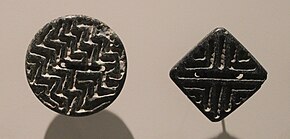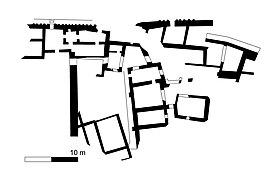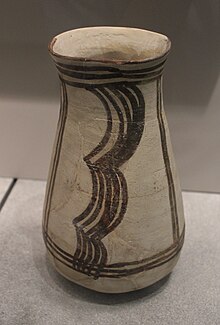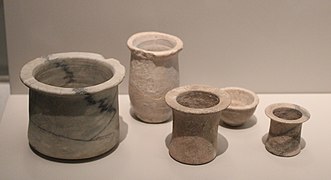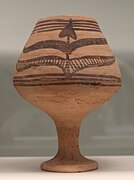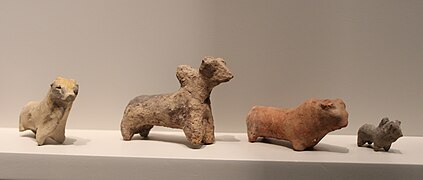Mundigak
Coordinates: 31 ° 54 ′ 14 " N , 65 ° 31 ′ 47" E
Mundigak ( Pashtun منډیګک) is an archaeological dig site in Afghanistan , about 55 km northwest of Kandahar . These are the remains of one of the earliest cities in the area between India and Iran . The city is attributed to the Helmand culture , which is also attested in eastern Iran. Excavations from 1951 to 1958 brought to light the remains of a considerable city complex with city walls, a palace and a temple. Before these excavations, little was known about the prehistory of Afghanistan. The discovery of a relatively large, prehistoric city in Afghanistan shed a whole new light on the development of cultures in the area between Iran and India. A large part of the finds was unparalleled, so that a detailed dating of the individual settlement phases was problematic and is still controversial today. The city had possibly up to 10,000 residents; in its heyday it took up an area of about 32 hectares.
The area of the Helmand culture can possibly be equated with an ancient state structure. Mundigak would be the second most important city there after Schahr-e Suchte .
location
The remains of the city are located about 55 km northwest of Kandahar in the valley of the Kushk-i Nakhud river, which now only has seasonal water and has dried up, especially in summer. Further south it flows into the Helmand . The place probably gained its importance due to its location on important trade routes. It was assumed that from here lapis lazuli , which was mined in northern Afghanistan, was traded to Iran. The field of ruins is dominated by various hills. Tépé (hill) A is the highest of them. The excavations were concentrated here and the most important finds were made here.
Excavations
During French excavations from 1951 to 1958 in ten campaigns under the direction of Jean Marie Casal as part of the La Délégation archéologique française en Afghanistan , different levels of settlement could be distinguished. The excavations took place in eleven places in the excavation area. On Tépé (area) A, the highest point in the city, remains of a palace were excavated in layers IV.1 and V. Urban areas from almost all periods of the place were found here. Area C is northwest of Area A. Only a small area has been excavated here, with the remains reaching back to Layer III. In the other parts of the city, diverse, larger or smaller areas were exposed (areas B, D to I and P and R), whereby mainly remnants of layer IV came to light, which is the best documented layer. In area P, remnants of layer V came to light, which is otherwise only documented in area A. The upper layers in particular had completely disappeared due to erosion. In area A, a large palace was uncovered in layer V on the remains of the older palace. Otherwise, however, layer V is not easy to cover in the city. Most of the finds are now in the National Museum in Kabul and in the Museum Guimet in Paris. The excavator Jean Marie Casal had been employed in the latter museum since 1957.
Layers I to III
The lowest layer (I) was only excavated in the central mound (area A). It probably dates to the fifth millennium BC. BC Layer I was divided into five sub-layers by the excavator (I.1–5). The first evidence of permanent buildings comes from layer I.3. House floor plans have only been preserved for layers I.4 and I.5. In these layers the buildings were rather simple. These are rectangular adobe residential buildings that consisted of one to three small rooms. The ceramic from layer I is dominated by open forms. In particular, fragments of shells have been found. The pottery is partly painted, with simple geometric patterns predominating. Painted animals are also very rare. Layer I.5 and the following layer II were separated by a thick layer of ash, which indicates that the place was uninhabited for a long time, at least in this area.
Layer II was divided into four sub-layers by the excavator: II.1, II.2, II.3a and II.3b. The population density in area A increased. Various multi-room buildings could be excavated. There was a deep well in one courtyard. Compared to layer I, however, the quality of the ceramic decreases. There are far fewer painted types. Many pots are rather rough.
Layer III is mainly known from area A, where six sub-layers were distinguished. The remains of a cemetery come from Area C, which was also occupied by Layer IV. The dead lay here in a crouched position. There were hardly any additions. Only in one case were pearls used as a bracelet. The development in area A is now even denser. They are mostly smaller houses with two or three rooms. Seals with geometric patterns also come from this layer.
Layer IV and V
In Layer IV, Mundigak developed into a fully formed city with a palace and temple. It can be concluded that there is an advanced social structure. However, there is no evidence for the use of writing. The excavator distinguished three sub-layers: IV.1, IV.2 and IV.3.
palace
In the center of the city is Hill A, on which extensive remains of a palace complex were found. It is uncertain whether it was really a palace as the excavator suspected, but the building undoubtedly served a public function. The building was extensively surrounded by a wall. To create a platform for the construction, older houses standing on the hill were leveled. The north facade of the palace was decorated with a row of pilasters that were stuccoed and painted white. At the top, these pilasters were bordered by a decorated tile ledge. Some of them were still two meters high when they were excavated. The actual palace consisted of various rooms and a courtyard. The east, south and west facades of the building were not preserved, but they may also have been decorated with pilasters. It was possible to distinguish between three renovation phases, all of which date to layer IV.1. The later palace from Layer IV.2 and Layer IV.3 had completely fallen victim to the renovation work in Layer V.
temple
About 200 m east of the palace stood a monumental building that was probably a temple built on virgin soil. It stood on a flat, approximately 2.5 m high hill and had a monumental outer wall, which was decorated on the outside with mighty buttresses, triangular in plan. The foundations were made of stone. Inside the complex there was a courtyard with the actual temple in the middle.
About 350 m south of hill A, parts of another large adobe building were excavated (excavation area F), which certainly also had a public function. There was a courtyard with a large water basin and various rooms arranged around it.
Wall and residential city
The residential quarters have only been partially excavated. To the west of the palace, the remains of a wall could be traced in various places. It consisted of two outer walls. The interior was divided by partitions; this created a series of interior rooms that were accessible through doors on the inside of the wall. There were supporting pillars on the outer facade. A corner of the wall has been found. Here stood a tower with four interiors and once with perhaps four pillars on each side. Only on the north side are all four preserved. Already in layer IV.1, the area around the wall was densely built on both sides with simple houses, which mostly consisted of a few rooms. The function of this wall is uncertain; it may have enclosed the palace extensively. About 90 m to the west (excavation area E) were again the remains of a second wall, which was constructed in a similar way and could be traced over a length of about 120 m. This was probably the actual city wall. Apart from that, residential buildings occurred mainly in excavation area D, where the city wall still stood in layer IV.1; the area in layer IV.2, on the other hand, was built on with simple residential buildings.
Layer V
Layer V was very poorly preserved due to the erosion of the excavation area. On the main hill, on the remains of the old palace, a large building was erected (called the Monument Massif by the excavators ), with the old structures buried and partially preserved under the new and very massive building. A monumental ramp leading to a platform was still preserved during the excavations. This consisted of a number of rooms that could not be entered, so they had a pure support function. The actual building on this platform has completely disappeared. In other parts of the city there is also evidence of development during this period, but the remains are very poorly preserved. However, it is clear that Mundigak continued to be a significant city in Layer V, but the remains of it have largely disappeared. After that, the place appears to have been abandoned. After 2500 BC There was no longer a city here. This is particularly noteworthy as there is no chronological overlap with the Indus culture .
Layer VI and VII
No structural remains have been preserved from layer VI. In addition to fireplaces, there were primarily numerous ceramics that have similarities with that of the earlier layers. The excavator suspects that these remains came from nomads. It seems that the population gave up their lifestyle in permanent settlements and moved to nomadism. This can also be observed in other places in Afghanistan and India. The last development is called Layer VII. These are various agricultural storehouses that probably date back to the 1st millennium BC. To date.
Finds
The finds include numerous terracotta figures, which often depict people, mostly women, but also men. There are also frequent depictions of cattle. In addition, in the remains of Layer IV, the head of a limestone man's statue was found. It is the only object that can be called a work of art in the narrower sense. The face is rather roughly worked. The eyes and eyebrows are heavily stylized. The man has short hair and a headband that ends in two falling strips of fabric at the back. Statues were also found sporadically in the Indus culture, in the oasis culture spread around the same time in the north and in Schahr-e Suchte, which is also attributed to the Helmand culture. The statues show a man kneeling on the floor, often described as the priest-king . It has been suggested that Mundigak's head also belonged to such a figure, but this cannot be proven.
Pottery is particularly important for small finds. Much of the ceramic is painted, some of it polychrome. Various decoration traditions can be proven that are also known from other places and thus help to locate Mundigak in the context of other cultures and thus also in time. The excavation report largely focuses on decorated forms, so the undecorated pottery is less well known. There were hand-formed vessels, but also those that were made on the potter's wheel. Layers I and II are dominated by simple, painted geometric patterns, often on the upper edge of bowls; in layer III the painting becomes more complex. There are still predominantly geometric patterns that belong to the so-called Quetta style . Others are painted in the style of the Nal culture or have similarities with ceramics of the Amri culture . In Layer IV there are also isolated figurative representations, especially cattle. Various clay goblets are from Layer IV and are decorated with rows of animals painted black, but also with individual plants. A group of these chalices was found in room XXII in the palace. The goblets exposed there were intact.
From Layer IV there are also two larger ceramic vessels with a sliding lid that may have served as mouse traps. Comparable mouse traps are known from Mohenjo-Daro in the Indus Valley. The corresponding finds from Mundigak are probably several centuries older.
Spinning whorls are from layer I.4. testified, of which there were two types: one has a conical shape and are made of clay, the others are disc-shaped and carved from stone. Stone vessels are attested in almost all layers.
From layer I.2 onwards, bronze objects are attested. First of all, they are simple tools like needles and weapons. However, the remains of a mirror also come from layer IV. An investigation showed that these artifacts were mostly made of bronze with a low tin content. Five objects with iron elements from Layer IV are noteworthy. The iron always served as a decoration for bronze objects; there were no artifacts made entirely of iron.
Gallery: Finds mainly from Layer IV
Dating
The chronological classification of the layers varies in research by almost 500 years. With this, especially with the dating of the fully developed city of Layer IV, the question of the relationship to the Indus culture is connected. With an early dating of Mundigak it can be assumed that the place provided decisive impulses for the development of the Indus culture. In the case of a late dating, Mundigak would be a roughly simultaneous city, which in various, but mostly older, publications is even regarded as part of the Indus culture.
Different dating approaches for Layer IV
- Mario Liverani (1998): 2700-1800 BC Chr.
- Vincent C. Pigott (1999): 2600-2100 BC. Chr.
- E. Cortesi, M. Tosi, A. Lazzari, M. Vidale (2008), before 2100 BC Chr.
- Jean-François Jarrige, Aurore Didier, Gonzague Quivron (2011): before 2500 BC Chr.
- Mukhrat Ahmed (2014): 2500-2300 BC Chr.
The dating of the individual layers is therefore problematic. At the time of the excavation there were only a few comparative finds. Various material samples were sent to two laboratories (University of Chicago, Gif-sur-Yvette) for C14 investigations, but they only provided limited usable results. A sample from Layer III.2 produced the date 2624 ± 200 BC. Other samples gave a date of 2037 ± 235 BC for layer I.5. And for layer III.5 the date 2253 ± 240 BC. According to this, layer III would be older than layer I. The C14 samples may have been contaminated.
However, recent research gives more weight to early dating. There are many similarities to Shahr-e Suchte in Iran today . Both sites, along with a few others, are therefore referred to as the Helmand culture . It is agreed that Layer III in Schahr-e Suchte coincides with Layer IV in Mundigak. In 2008 a group of archaeologists published an article, the aim of which was to show that the Helmand culture (especially layer IV in Mundigak) coincides with the Indus culture. A short time later, a study was published that aims to prove exactly the opposite, namely that the flowering of the Helmand culture must be set before the Indus culture.
Layer I ceramics have similarities with the pottery from Mehrgarh and thus probably dates back to the 5th millennium BC. Chr. Jean-François Jarrige published a vessel fragment from Layer III.6, which has parallels in the Dschemdet-Nasr period (3100–2900 BC) in Mesopotamia. Some vessels from Layer IV have parallels in Kot Diji (3400 to 2650 BC), a place in Pakistan that belongs to an early phase of the Indus civilization. Layer III in Sohr Damb in Pakistan has connections with Layer IV in Mundigak. Based on C14 data, this layer can be estimated around 2800/2700 BC. To be dated.
literature
- Bridget and Raymond Allchin: The Rise of Civilization in India and Pakistan. Cambridge 1982, ISBN 978-0-521-28550-6 .
- Warwick Ball: Archaeological Gazetter of Afghanistan / Catalog des Sites Archéologiques D'Afghanistan. Volume 1, Editions Recherche sur les civilizations, Paris 1982.
- Jean Marie Casal: Fouilles de Mundigak . Paris 1961 (excavation report).
Web links
- Ceramics from Mundigak
- Mundigak . harappa.com
Individual evidence
- ↑ Philippe Beaujard: Part I - The Ancient Routes of Trade and Cultural Exchanges and the First States (Sixth – Second Millennium bce) , in: Philippe Beaujard, The Worlds of the Indian Ocean 2 Hardback Book Set: The Worlds of the Indian Ocean: A Global History : Vol. 1, Cambridge, ISBN 978-1-108-42456-1 , p. 100.
- ↑ Jane McIntosh: The Ancient Indus Valley: New Perspectives , Santa Barbara, California, ISBN 978-1-57607-908-9 , pp. 86-87.
- ^ Bridget and Raymond Allchin: The Rise of Civilization in India and Pakistan . London, New York, Bew Rockwell, Melbourne, Sydney 1982, ISBN 0-521-24244-4 , pp. 132-133.
- ↑ Philippe Beaujard: Part I - The Ancient Routes of Trade and Cultural Exchanges and the First States (Sixth – Second Millennium bce) , in: Philippe Beaujard, The Worlds of the Indian Ocean 2 Hardback Book Set: The Worlds of the Indian Ocean: A Global History : Vol. 1, Cambridge, ISBN 978-1-108-42456-1 , p. 112.
- ↑ Casal: Fouilles de Mundigak , pp. 23-27.
- ↑ Petrie and Schaffer, in: Allchin, Ball, Hammond (eds.): The Archeology of Afghanistan, From earliest Times to the Timurid Period , pp. 189–191.
- ↑ Cameron A. Petrie and Jim G. Schaffer: A Helmand civilsation south of the Hindu Kush , in: Raymond Allchin, Warwick Ball, Norman Hammond (eds.): The Archeology of Afghanistan, From earliest Times to the Timurid Period , Edinburgh: University Press, 2019, ISBN 978-0-7486-9917-9 , pp. 166-173.
- ↑ Casal: Fouilles de Mundigak , pp. 29-32, Figs. 6-7.
- ↑ Casal: Fouilles de Mundigak , pp. 126-28, Figs. 49-50.
- ↑ Casal: Fouilles de Mundigak , pp. 33-36.
- ↑ Casal: Fouilles de Mundigak , pp. 126-28, Figs. 63-65.
- ↑ Casal: Fouilles de Mundigak , pp. 79-81, Figs. 42.
- ↑ Petrie and Schaffer, in: Allchin, Ball, Hammond (eds.): The Archeology of Afghanistan, From earliest Times to the Timurid Period , pp. 187-189.
- ^ E. Cortesi, Maurizio, Tosi, A. Lazzari, Massimo Vidale: Cultural Relationships beyond the Iranian Plateau: The Helmand Civilization, Baluchistan and the Indus Valley in the 3rd Millennium BCE . In: Paléorient , 2008, Vol. 34, No. 2, p. 26.
- ↑ Casal: Fouilles de Mundigak , pp. 91-92.
- ↑ Casal: Fouilles de Mundigak , pp. 76-77, 255, plates XLIII, XLIV; Victor Sarianidi : The Art of Ancient Afghanistan. Architecture, ceramics, seals, works of art made of stone and metal . VCH, Acta Humaniora, Weinheim 1986, ISBN 3-527-17561-X , p. 113, plates 28, 29 on 117, plate 36 on p. 124; Image of the head on Harappa.com .
- ↑ Massimo Vidale: A Priest King at Shahr-i Sokhta? , in: Archaeological Research in Asia 15 (2018), p. 111
- ↑ Petrie and Schaffer, in: Allchin, Ball, Hammond (eds.): The Archeology of Afghanistan, From earliest Times to the Timurid Period , pp. 192-216.
- ↑ Casal: Fouilles de Mundigak , pp. 182-184, Figs. 62-65, PL. XXXII.
- ↑ Casal: Fouilles de Mundigak , p. 145, nos. 314, 314a, p. 197. Fig. 84.
- ↑ E. Cortesi sem-linkM. Tosi sem-link A. Lazzari, M. Vidale: Cultural Relationships beyond the Iranian Plateau: The Helmand Civilization, Baluchistan and the Indus Valley in the 3rd Millennium BCE , in: Paléorient , 2008, Vol. 32, No. 3, pp. 5-35 ; see also the website of Yves Traynard with a picture of the mousetrap that is on display in the Musee Guimet today .
- ↑ Casal: Fouilles de Mundigak, p. 232, Fig. 133.
- ↑ Casal: Fouilles de Mundigak, pp. 233-234, Fig. 134.
- ↑ Petrie and Schaffer, in: Allchin, Ball, Hammond (eds.): The Archeology of Afghanistan, From Earliest Times to the Timurid Period , pp. 218-221.
- ^ VC Pigott: The Archaeometallurgy of the Asian Old World , Philadelphia 1999, ISBN 0-924171-34-0 , p. 159.
- ↑ Jonathan M. Kenoyer, Heather M.-L. Miller: Metal Technologies of the Indus Valley Tradition in Pakistan and Western India , VC Pigott (Ed.): The archaeometallurgy of the Asian Old World , Philadelphia: The University Museum, University of Pennsylvania. ISBN 978-0-924171-34-5 , p. 121.
- ^ The Ancient Near East , London, New York 2014, ISBN 978-0-415-67905-3 , p. 182.
- ^ The Archaeometallurgy of the Asian Old World, Philadelphia 1999, ISBN 0-924171-34-0 , p. 159.
- ^ Cultural Relationships beyond the Iranian Plateau: The Helmand Civilization, Baluchistan and the Indus Valley in the 3rd Millennium BCE , in: Paléorient , 2008, Vol. 34, No. 2, pp. 5-35 .
- ↑ Shahr-i Sokhta and the chronology of the Indo-Iranian regions , In: Paléorient , 2011, vol. 37, no. 2, pp. 7-34.
- ↑ Anicent Pakistan, An Archaeological History , Reidsville 2014, ISBN 978-1-4959-6643-9 , p. 222.
- ↑ Casal: Fouilles de Mundigak , p. 258.
- ↑ M. Tosi, S. Malek Shahmirzadi, MA Joyenda: The Bronze Age in Iran and Afghanistan . In: History of Civilizations of Central Asia. Vol. I: The Dawn of Civilization: Earliest Times to 700 BC UNESCO, Paris 1992, ISBN 978-92-3-102719-2 , p. 199.
- ^ E. Cortesi, M. Tosi, A. Lazzari, M. Vidale: Cultural Relationships beyond the Iranian Plateau: The Helmand Civilization, Baluchistan and the Indus Valley in the 3rd Millennium BCE . In: Paléorient, 2008, Vol. 34, No. 2, pp. 5-35.
- ↑ Jean-François Jarrige, Aurore Didier, Gonzague Quivron: Shahr-i Sokhta and the chronology of the Indo-Iranian regions , In: Paléorient , Volume 37, No. 2, 2011, p. 18.
- ↑ Jean-François Jarrige, Aurore Didier, Gonzague Quivron: Shahr-i Sokhta and the chronology of the Indo-Iranian regions , In: Paléorient , 2011, vol. 37, no. 2, pp. 7-34.
- ↑ J.-F. Jarrige: Une jarre polychrome à tenon perforé de Mundigak . In: G. Gnoli and L. Lanciotti (eds.), Orientalia Iosephi Tucci Memoriae Dicata , Rome: IsMEO (series orientale 56,2), pp. 661-666.
- ↑ Jean-François Jarrige, Aurore Didier, Gonzague Quivron: Shahr-i Sokhta and the chronology of the Indo-Iranian regions . In: Paléorient , 2011, Vol. 37, No. 2, p. 18.
- ↑ Jochen Görsdorf, Ute Franke-Vogt: Implication of Radiocarbon Dates from Sohr Damb / Nal Balochistan . In: Radiocarbon , 2007, Vol. 49, No. 2, p. 706.


